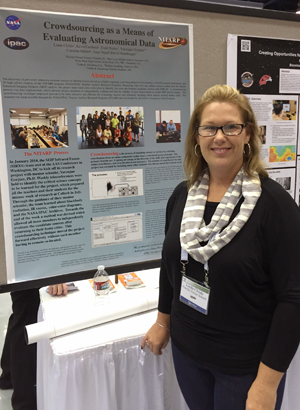Becoming a Student Again with Astronomical Research
 Last year I was honored to be chosen as a NITARP teacher.
Last year I was honored to be chosen as a NITARP teacher.
NITARP, short for the NASA/IPAC Teacher Archive Research Program, pairs teachers with astronomers from Caltech and NASA, and allows the teachers to do authentic astronomical research.
I thought this program would be something that was a little out of my comfort zone, as I only had classroom experience (like most science teachers), but I decided to apply anyway as it would be an educational experience. To my surprise, I was one of eight teachers that was accepted out of hundreds of applicants.
The teachers were split up into two teams, each with an astronomer to lead them. My team had educators from Boston, Colorado, and California and my astronomer, Varoujan Gorjian, was from Caltech and NASA.
The program kicked off in 2014 at the American Astronomical Society Conference held in Washington, DC. The team met with Varoujan to learn about the project he had chosen for us. We would be using data from the Spitzer Enhanced Imaging Products Catalogue to find really bright objects and see what they were. The Spitzer Space telescope is an infrared telescope that detects excess heat. Every object in the universe gives off heat, but some objects give off much more than others, making them very interesting. We had weekly 9 p.m. teleconference to discuss the science behind our project and to start culling through data.
Little did I know what this experience would teach me.
I learned a lot about infrared telescopes and how to measure infrared excess using different wavelengths. I can now even explain to you what signal to noise ratio means as well as some calculus…gulp! And, guess what? We made mistakes and even had to go back and redo parts of the project due to bad data. It’s okay to make mistakes!
The most valuable piece of information I learned was that it’s okay not to know everything. There would be nights where we would be discussing the project and I was completely lost. Totally afraid to ask a question for fear I would sound stupid. Hey, wait a minute, don’t we hear that from our kids sometimes? Varoujan would say over and over, “Ask questions!” Don’t we tell our kids this?
My light bulb moment hit me at the conference in Seattle this year as we practiced presenting our project. I had been the teacher for so long that I forgot what it was like to be a student, to be fearful of being that one kid to ask questions and risk sounding stupid. I was afraid to get it wrong, so I often stayed silent! I was terrified to practice my elevator speech for the project in front of everyone. I did it though, stumbled with my words, got sweaty palms, but I did it! And the day we presented, I was able to explain to astronomers what we did and how we did it. And even answer some of their scary, complicated questions! Such a great feeling!
I came back to my classroom after my trip with a new perspective on my students.

Now, when we talk, I tell them about my experience this past year and how I know all about the feeling of being terrified to ask a question! Sure, we tell our kids, ask away, but do we really remember what that feeling is like? I know I had forgotten, but through this amazing experience, I now remember.
So next time you tell your students or kids that they can always ask questions, remember that to some, being wrong or sounding stupid is their biggest fear. Trust me, I was that kid for the last year!
Additional Resources:
The SEIP Infrared Excess (SIRXS) team (Includes team publications & research posters)
NITARP: Linda Childs
Photo credit: Artist’s conception of NASA’s Spitzer Space Telescope
